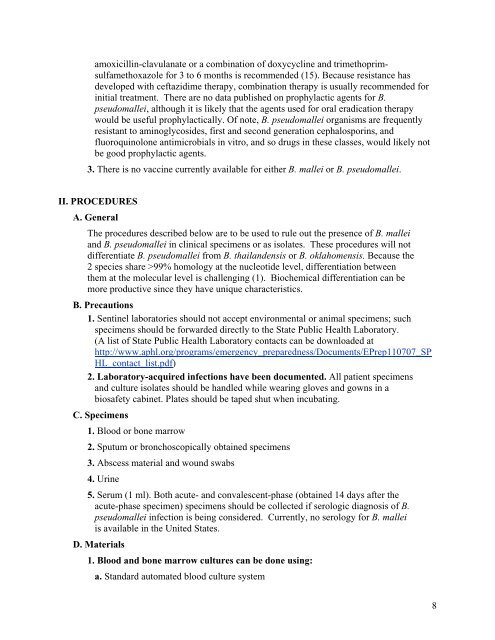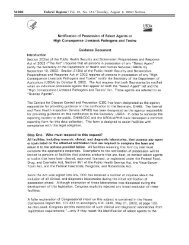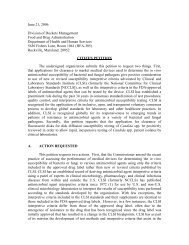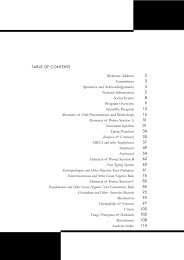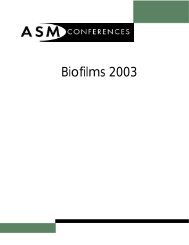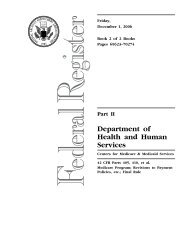Burkholderia mallei and B. pseudomallei - Microbiology - American ...
Burkholderia mallei and B. pseudomallei - Microbiology - American ...
Burkholderia mallei and B. pseudomallei - Microbiology - American ...
Create successful ePaper yourself
Turn your PDF publications into a flip-book with our unique Google optimized e-Paper software.
amoxicillin-clavulanate or a combination of doxycycline <strong>and</strong> trimethoprimsulfamethoxazolefor 3 to 6 months is recommended (15). Because resistance hasdeveloped with ceftazidime therapy, combination therapy is usually recommended forinitial treatment. There are no data published on prophylactic agents for B.pseudo<strong>mallei</strong>, although it is likely that the agents used for oral eradication therapywould be useful prophylactically. Of note, B. pseudo<strong>mallei</strong> organisms are frequentlyresistant to aminoglycosides, first <strong>and</strong> second generation cephalosporins, <strong>and</strong>fluoroquinolone antimicrobials in vitro, <strong>and</strong> so drugs in these classes, would likely notbe good prophylactic agents.3. There is no vaccine currently available for either B. <strong>mallei</strong> or B. pseudo<strong>mallei</strong>.II. PROCEDURESA. GeneralThe procedures described below are to be used to rule out the presence of B. <strong>mallei</strong><strong>and</strong> B. pseudo<strong>mallei</strong> in clinical specimens or as isolates. These procedures will notdifferentiate B. pseudo<strong>mallei</strong> from B. thail<strong>and</strong>ensis or B. oklahomensis. Because the2 species share >99% homology at the nucleotide level, differentiation betweenthem at the molecular level is challenging (1). Biochemical differentiation can bemore productive since they have unique characteristics.B. Precautions1. Sentinel laboratories should not accept environmental or animal specimens; suchspecimens should be forwarded directly to the State Public Health Laboratory.(A list of State Public Health Laboratory contacts can be downloaded athttp://www.aphl.org/programs/emergency_preparedness/Documents/EPrep110707_SPHL_contact_list.pdf)2. Laboratory-acquired infections have been documented. All patient specimens<strong>and</strong> culture isolates should be h<strong>and</strong>led while wearing gloves <strong>and</strong> gowns in abiosafety cabinet. Plates should be taped shut when incubating.C. Specimens1. Blood or bone marrow2. Sputum or bronchoscopically obtained specimens3. Abscess material <strong>and</strong> wound swabs4. Urine5. Serum (1 ml). Both acute- <strong>and</strong> convalescent-phase (obtained 14 days after theacute-phase specimen) specimens should be collected if serologic diagnosis of B.pseudo<strong>mallei</strong> infection is being considered. Currently, no serology for B. <strong>mallei</strong>is available in the United States.D. Materials1. Blood <strong>and</strong> bone marrow cultures can be done using:a. St<strong>and</strong>ard automated blood culture system8


